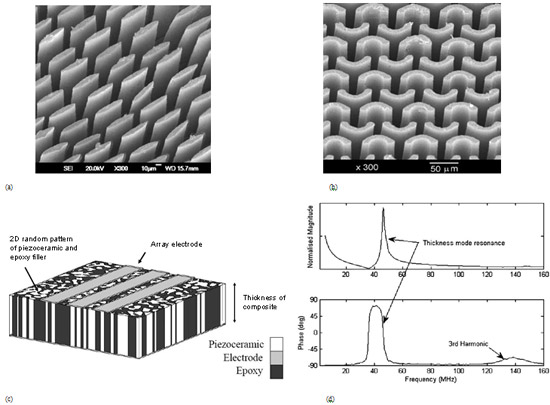High Frequency Transducers and Arrays
JC Bamber, NL Bush; in collaboration with S Cochran, C Demore et al, University of Dundee; T Button et al, University of Birmingam; D MacLennan, University of Strathclyde
Source of funding: EPSRC
High resolution ultrasound reflex transmission imaging (described in previous department reports), elastography (figure 1 below) and photoacoustic imaging (Figure 1 below), for skin tumour diagnosis and preclinical research, represent examples of applications that are in great need of high frequency arrays to permit rapid real-time imaging with electronic scanning and focusing. Conventional dice-and-fill fabrication methods restrict the array pitch, which limits the operating frequency.
We have participated in a multi-centre project that developed technology for kerfless array fabrication using micro-moulded piezocomposites. Micromoulded piezocomposites with material properties suitable for high frequency imaging have been made by our collaborators, and microfabrication techniques developed and adapted to pattern fine-scale arrays on composite surfaces. Kerfless arrays with 15 μm element pitch (i.e wavelength spacing for 100 MHz) were made and performed as expected. A new technique for designing high frequency piezocomposites was developed to suppress undesired vibration modes. By introducing a distribution of shapes and sizes to the lateral and elevation dimension of the ceramic segments of the composite, only the coherent thickness-mode vibration is reinforced. Non-pillar ceramic segments can also improve the structural integrity of the final composite. Ellipses and arcs have been fabricated (Figures 1a and 1b), and work as intended.
We have also assisted with, and patented, a method that performed particularly well in finite element simulation and involves an algorithm to generate a random ceramic pattern (Figures 1c). The predicted responses contain no significant spurious modes even up to the third harmonic frequency (Figure 1d), with the strongest electromechanical coupling coefficient that can be expected for this volume fraction, and evidence that the design would function well even when the dimension of the random structure is large relative to the thickness. The technique may therefore also have value at lower frequencies.
 Figure 1. (a) Ellipsoidal pillars of PZT-5H moulded ceramic prior to filling with epoxy to make the piezocomposite; (b) similar to (a), but for arc-shaped pillars; (c) diagram of a kerfless array section with micro-moulded piezocomposite containing a randomized pattern of piezoceramic and epoxy filler; (d) finite element model (PZFlex™) prediction of the electrical impedance spectra to be expected of a 40 µm thick composite such as that in (c) where the random pattern was defined by a Gaussian autocorrelation function with correlation length 10 µm thresholded to give 40% ceramic volume fraction
Figure 1. (a) Ellipsoidal pillars of PZT-5H moulded ceramic prior to filling with epoxy to make the piezocomposite; (b) similar to (a), but for arc-shaped pillars; (c) diagram of a kerfless array section with micro-moulded piezocomposite containing a randomized pattern of piezoceramic and epoxy filler; (d) finite element model (PZFlex™) prediction of the electrical impedance spectra to be expected of a 40 µm thick composite such as that in (c) where the random pattern was defined by a Gaussian autocorrelation function with correlation length 10 µm thresholded to give 40% ceramic volume fraction.